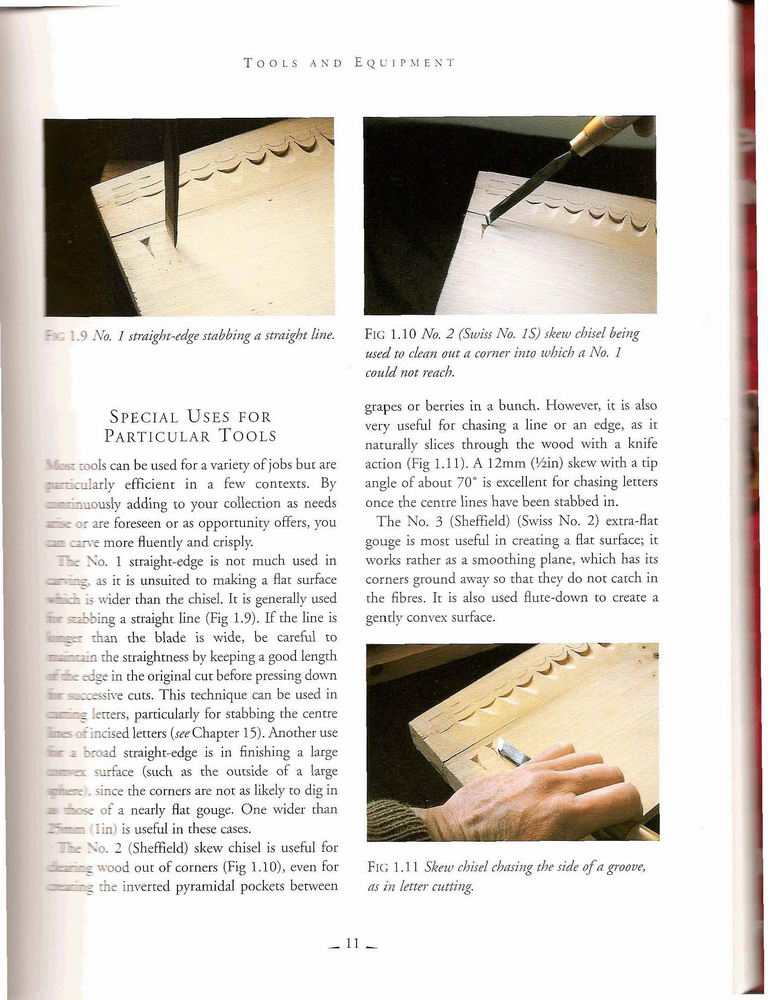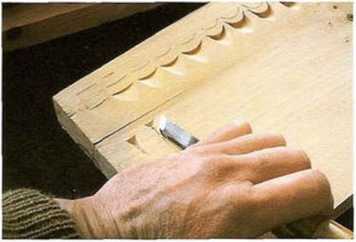essentÊrving°11

9 No. 1 straight-edge stabbing a straight linÄ.
Special Uses for Particular Tools
- :ooIs can be uscd for a variety of jobs but are ramcularly cfFicient in a few concexts. By sa â ⢠uously adding to your collection as needs
:: are foreseen or as opportuniry offers, you - .ir:t morÄ fluently and crisply.
No. 1 straight-edge is not much used in âr ng. as it is unsuitcd to making a fiat surface
- ;> wider than the chisel. It is generally used
- cirbing a straight linÄ (Fig 1.9). If the linÄ is
than the blade is wide, be careful to ~ * i:n the straightness by keeping a good length
mi : : rdge in the original cut before pressing down ii _;jessive cuts. This tcchnique can be used in -.g ietters, parcicularly for stabbing the cencre
- - :;r.cised Ietters {seeChapter 15). Another use far i -r ad straight-edge is in finishing a large = - . surface (such as the ouiside of a large
ince the corncrs are not as likely to dig in ⢠. of a ncarly fiat gouge. One wider than
- - i in i is useful in thcse cases.
Tir No. 2 (Sheffield) skew chisel is useful for wood out of corncrs (Fig 1.10), even for
- £ :he inverted pyramidal pockets berween
Fic; 1.10 No. 2 (Swiss No. IS) skew chisel being used to clean out a corner into which a No. I could not reach.
grapcs or berrics in a bunch. Howcver, it is also very useful for chasing a linÄ or an edge, as it naturally slices through the wood with a knife action (Fig 1.11). A 12mm (â/ain) skew with a tip angle of about 70* is excellent for chasing Ietters once the centre lines have been stabbed in.
The No. 3 (Sheffield) (Swiss No. 2) extra-flat gouge is most useful in creating a fiat surface; it works rather as a smoothing piane, which has its corners ground away so that they do not catch in the fibres. It is also used flute-down to create a gcntly convex surface.

Fic; 1.11 Skew chisel chasing the side of a groooe, as in letter cutting.
Wyszukiwarka
Podobne podstrony:
essent?rving?07 T O O I. S AND E Q U I P M E X T : .2 No. 1 straigbt-edge and No.
MZZ2010B0044 ROOM STRAIGHT-LINE DIMENSIONS (2) Shows position and shape ot the polnlsShows dctails o
Pertanika 14(1). 77-81(1991)COMMUNICATION IIDetemiination of Best Straight LinÄ Graphs in the Underg
112 Zofia Kaczorowska LIST OF TABLES Table 1. EÄ uations of straight-line regression. Period from beg
img043 3 PRACTICAL TATTINGEDGING A I used no. 50 DMC Cordonnet Special cotton for this edging. The f
img043 3 PRACTICAL TATTINGEDGING A I used no. 50 DMC Cordonnet Special cotton for this edging. The f
img043 3 PRACTICAL TATTINGEDGING A I used no. 50 DMC Cordonnet Special cotton for this edging. The f
img187 187 4. Duc N.Q.: LinÄ Coding Techniques for Baseband Oigital Transmission. Australian Telecom
1933 League of Nations â Treaty Series. 85 Article XI. Special Labels for Insured Parcels, etc.
pictures 2(1) FinaÅ Fantasy XIII & XHI-2 [Special Edition] Version 3.5.0.0 File Tools Info
R
Starting Multiple MySQL Instances atthe Windows Command LinÄ The procedurÄ for starting a single MyS
8 (727) A SiartJ £>rt (Ute No. 30 Crochet Cotton and 2 Shuttles) LARGE DOIÅY For Motif*: R 3 ds,
Art education room in the National Museum of Cuba, Hayana In March 1968, a room specially prepared f
27623 system 111 111MY SPECIAL EXERCISES FOR THE NECK These are not included in " My System â b
Knit-on Facings A Special Tip for Armhole Facings on Sleeveless Sweaters and Vests So that
wiÄcej podobnych podstron